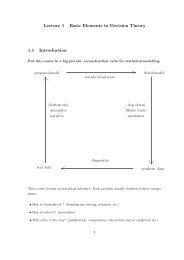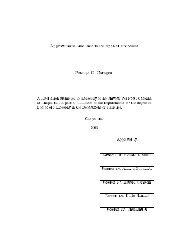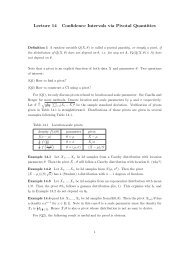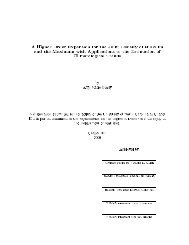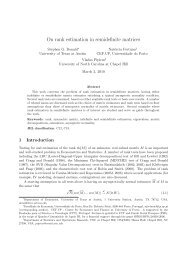Monte Carlo Methods in Statistical Mechanics: Foundations and ...
Monte Carlo Methods in Statistical Mechanics: Foundations and ...
Monte Carlo Methods in Statistical Mechanics: Foundations and ...
You also want an ePaper? Increase the reach of your titles
YUMPU automatically turns print PDFs into web optimized ePapers that Google loves.
m<strong>in</strong>imizer we know, namely =0! Thegoalofthis coarse-grid correction step is to<br />
reduce signi cantly the low-frequency components ofthe error <strong>in</strong> ' (hopefully without<br />
creat<strong>in</strong>g large new high-frequency error components).<br />
3) Post-smooth<strong>in</strong>g. We apply, for good measure, a few more sweeps of the basic<br />
smoother. (This would protect aga<strong>in</strong>st any high-frequency error components which<br />
may <strong>in</strong>advertently have been created by the coarse-grid correction step.)<br />
The forego<strong>in</strong>g constitutes, of course, a s<strong>in</strong>gle step of the multi-grid algorithm. In<br />
practice this step would be repeated several times, as <strong>in</strong> any other iteration, until the<br />
error has been reduced to an acceptably small value. The advantage of multi-grid over<br />
the traditional (e.g. damped Jacobi) iterative methods is that, with a suitable choice<br />
of the <strong>in</strong>gredients pll;1, Sl <strong>and</strong> so on, only a few (maybe ve orten) iterations are<br />
needed to reduce the errortoasmall value, <strong>in</strong>dependent of the lattice sizeL. This<br />
contrasts favorably with the behavior (5.13) of the damped Jacobi method, <strong>in</strong> which<br />
O(L 2 )iterations are needed.<br />
The multi-grid algorithm is thus a general framework the userhas considerable<br />
freedom <strong>in</strong> choos<strong>in</strong>g the speci c <strong>in</strong>gredients, which must be adapted to the speci c<br />
problem. We now discuss brie y each ofthese <strong>in</strong>gredients more details can be found<br />
<strong>in</strong> Chapter 3 of the book of Hackbusch [32].<br />
Coarse grids. Most commonly one usesauniform factor-of-2 coarsen<strong>in</strong>g between<br />
each grid l <strong>and</strong> the next coarser grid l;1. The coarse-grid po<strong>in</strong>ts could be either a<br />
subset of the ne-grid po<strong>in</strong>ts (Fig. 1) or a subset of the dual lattice (Fig. 2). These<br />
schemes have obvious generalizations to higher-dimensional cubic lattices. In dimension<br />
d =2,another possibility isauniform factor-of- p 2 coarsen<strong>in</strong>g (Fig. 3) note that the<br />
coarse grid is aga<strong>in</strong> a square lattice, rotated by 45. Figs. 1{3 are often referred to as<br />
\st<strong>and</strong>ard coarsen<strong>in</strong>g", \staggered coarsen<strong>in</strong>g", <strong>and</strong> \red-black (orcheckerboard) coarsen<strong>in</strong>g",<br />
respectively. Coarsen<strong>in</strong>gs by a larger factor (e.g. 3) could also be considered,<br />
but are generally disadvantageous. Note that eachofthe above schemes works also for<br />
periodic boundary conditions provided that the l<strong>in</strong>ear size Ll of the grid l is even. For<br />
this reason it is most convenient totake the l<strong>in</strong>ear size L LM of the orig<strong>in</strong>al ( nest)<br />
grid M to beapower of 2, or at least a power of 2 times a small <strong>in</strong>teger. Other<br />
de nitions of coarse grids (e.g. anisotropic coarsen<strong>in</strong>g) are occasionally appropriate.<br />
Prolongation operators. For a coarse grid as <strong>in</strong> Fig. 2, a natural choice of prolongation<br />
operator is piecewise-constant <strong>in</strong>jection:<br />
(pll;1'l;1) x1<br />
1<br />
2 x2<br />
1<br />
2<br />
= ('l;1)x1x2 for all x 2 l;1 (5.15)<br />
(illustrated here for d = 2). It can be represented <strong>in</strong> an obvious shorth<strong>and</strong> notation by<br />
the stencil "<br />
1<br />
1<br />
#<br />
1<br />
:<br />
1<br />
(5.16)<br />
For a coarse grid as <strong>in</strong> Fig. 1, a natural choice is piecewise-l<strong>in</strong>ear <strong>in</strong>terpolation, one<br />
29



